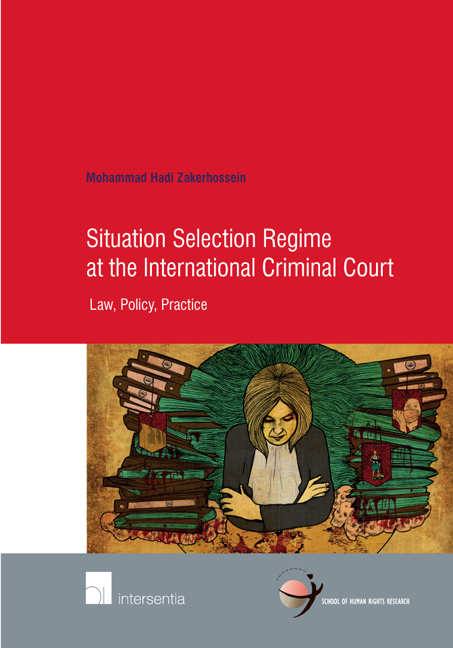Book contents
- Frontmatter
- Contents
- Acknowledgment
- Abbreviations
- General Introduction
- Part One Formulating the Concept of Situation in the Rome Statute Sense
- Part two Situation Selection Process
- Chapter I Trigger Mechanism
- Chapter II Identification Stage
- Chapter III Preliminary Examination
- Chapter IV Making a Decision on the Situation Selection
- Part three Situation Selection Criteria
- Part Four Situation Selection In Light Of Expressivism
- Conclusion
- Bibliography
- ICC Case Tables
- OTP Documents
- About the Author
- School of Human Rights Research Series
Chapter II - Identification Stage
from Part two - Situation Selection Process
Published online by Cambridge University Press: 13 October 2018
- Frontmatter
- Contents
- Acknowledgment
- Abbreviations
- General Introduction
- Part One Formulating the Concept of Situation in the Rome Statute Sense
- Part two Situation Selection Process
- Chapter I Trigger Mechanism
- Chapter II Identification Stage
- Chapter III Preliminary Examination
- Chapter IV Making a Decision on the Situation Selection
- Part three Situation Selection Criteria
- Part Four Situation Selection In Light Of Expressivism
- Conclusion
- Bibliography
- ICC Case Tables
- OTP Documents
- About the Author
- School of Human Rights Research Series
Summary
In the procedural architecture of the ICC, there is a distinct stage between the trigger mechanism and the preliminary examination. Upon the receipt of communications or referrals, the Prosecutor shall identify a situation before opening the preliminary examination. The responsibility of the Prosecutor to identify a situation primarily relates to communications, but it is not limited to them. The identification stage marks the first time in the situation selection process when the Prosecutor makes a selection in the context of communications and referrals.
In the literature on the ICC's procedure, this stage is mainly ignored. However, for instance, Ambos has briefly referred to the identification of a situation stage. However, this untouched stage deserves more attention. The Prosecutor has an authority to design situations. In the context of this stage of the situation selection process, this authority is exercised. This chapter provides insight into the functions of identification stage as to both communications (1) and referrals (2).
IDENTIFICATION IN THE CONTEXT OF COMMUNICATIONS
Contrary to the referring entities, those who send communications to the OTP do not report a situation. Communications just provide the Prosecutor with information that may lead to the identification of a situation.
FORMING A SITUATION FROM COMMUNICATIONS
The OTP Policy Paper on Preliminary Examinations establishes a ‘filtering process’ comprising of four phases, “in order to distinguish those situations that warrant investigation from those that do not, and in order to manage the analysis of the factors set out in Article 53(1)”. Phase 2 examines the jurisdiction of the Court, Phase 3 deals with the admissibility requirement and Phase 4 assesses the interest of the justice requirement. The first phase of this filtering system is an initial assessment the purpose of which is ‘to analyze and verify the seriousness of information received, filter out information on crimes that are outside of the jurisdiction of the Court and identify those that appear to fall within the jurisdiction of the Court’. Communications are analyzed by the Information and Evidence Unit at the OTP. The Unit will prepare reports analyzing the communications received. In Phase 1, the Unit categorizes the communications received in four different types.
- Type
- Chapter
- Information
- Situation Selection Regime at the International Criminal CourtLaw, Policy, Practice, pp. 97 - 110Publisher: IntersentiaPrint publication year: 2017

